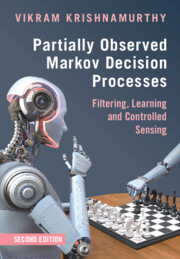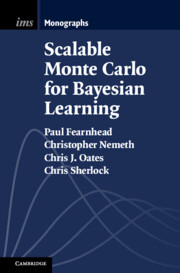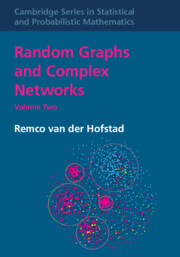Refine search
Actions for selected content:
980 results in Applied probability and stochastic networks
Contents
-
- Book:
- Scalable Monte Carlo for Bayesian Learning
- Published online:
- 16 May 2025
- Print publication:
- 05 June 2025, pp v-viii
-
- Chapter
- Export citation
14 - Stopping-Time POMDPs for Quickest Detection
- from Part III - POMDP Structural Results
-
- Book:
- Partially Observed Markov Decision Processes
- Published online:
- 16 May 2025
- Print publication:
- 05 June 2025, pp 376-400
-
- Chapter
- Export citation
3 - Stochastic Gradient MCMC Algorithms
-
- Book:
- Scalable Monte Carlo for Bayesian Learning
- Published online:
- 16 May 2025
- Print publication:
- 05 June 2025, pp 62-102
-
- Chapter
- Export citation
17 - Reinforcement Learning
- from Part IV - Stochastic Gradient Algorithms and Reinforcement Learning
-
- Book:
- Partially Observed Markov Decision Processes
- Published online:
- 16 May 2025
- Print publication:
- 05 June 2025, pp 445-465
-
- Chapter
- Export citation
Bibliography
-
- Book:
- Partially Observed Markov Decision Processes
- Published online:
- 16 May 2025
- Print publication:
- 05 June 2025, pp 605-628
-
- Chapter
- Export citation
9 - POMDPs in Controlled Sensing and Sensor Scheduling
- from Part II - POMDPs. Models, Algorithms and Applications
-
- Book:
- Partially Observed Markov Decision Processes
- Published online:
- 16 May 2025
- Print publication:
- 05 June 2025, pp 231-254
-
- Chapter
- Export citation
16 - Stochastic Optimization and Gradient Estimation
- from Part IV - Stochastic Gradient Algorithms and Reinforcement Learning
-
- Book:
- Partially Observed Markov Decision Processes
- Published online:
- 16 May 2025
- Print publication:
- 05 June 2025, pp 425-444
-
- Chapter
- Export citation
Part II - POMDPs. Models, Algorithms and Applications
-
- Book:
- Partially Observed Markov Decision Processes
- Published online:
- 16 May 2025
- Print publication:
- 05 June 2025, pp 163-164
-
- Chapter
- Export citation
Preface to Revised Edition
-
- Book:
- Partially Observed Markov Decision Processes
- Published online:
- 16 May 2025
- Print publication:
- 05 June 2025, pp xii-xiv
-
- Chapter
- Export citation
4 - Algorithms for Maximum Likelihood Parameter Estimation
- from Part I - Stochastic Models and Bayesian Inference
-
- Book:
- Partially Observed Markov Decision Processes
- Published online:
- 16 May 2025
- Print publication:
- 05 June 2025, pp 71-90
-
- Chapter
- Export citation
12 - Monotonicity of Value Function for POMDPs
- from Part III - POMDP Structural Results
-
- Book:
- Partially Observed Markov Decision Processes
- Published online:
- 16 May 2025
- Print publication:
- 05 June 2025, pp 312-326
-
- Chapter
- Export citation
Contents
-
- Book:
- Partially Observed Markov Decision Processes
- Published online:
- 16 May 2025
- Print publication:
- 05 June 2025, pp v-xi
-
- Chapter
- Export citation
5 - Multiagent Sensing: Social Learning and Data Incest
- from Part I - Stochastic Models and Bayesian Inference
-
- Book:
- Partially Observed Markov Decision Processes
- Published online:
- 16 May 2025
- Print publication:
- 05 June 2025, pp 91-113
-
- Chapter
- Export citation

Partially Observed Markov Decision Processes
- Filtering, Learning and Controlled Sensing
-
- Published online:
- 16 May 2025
- Print publication:
- 05 June 2025

Scalable Monte Carlo for Bayesian Learning
-
- Published online:
- 16 May 2025
- Print publication:
- 05 June 2025

Random Graphs and Complex Networks
-
- Published online:
- 08 February 2024
- Print publication:
- 08 February 2024
Frontmatter
-
- Book:
- Random Graphs and Complex Networks
- Published online:
- 08 February 2024
- Print publication:
- 08 February 2024, pp i-iv
-
- Chapter
- Export citation
8 - Small-World Phenomena in Preferential Attachment Models
- from Part III - Small-World Properties of Random Graphs
-
- Book:
- Random Graphs and Complex Networks
- Published online:
- 08 February 2024
- Print publication:
- 08 February 2024, pp 326-380
-
- Chapter
- Export citation
7 - Small-World Phenomena in Configuration Models
- from Part III - Small-World Properties of Random Graphs
-
- Book:
- Random Graphs and Complex Networks
- Published online:
- 08 February 2024
- Print publication:
- 08 February 2024, pp 289-325
-
- Chapter
- Export citation
Dedication
-
- Book:
- Random Graphs and Complex Networks
- Published online:
- 08 February 2024
- Print publication:
- 08 February 2024, pp v-vi
-
- Chapter
- Export citation
